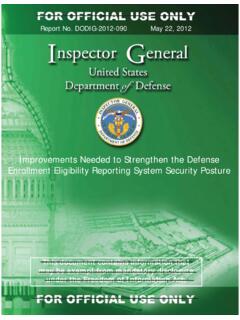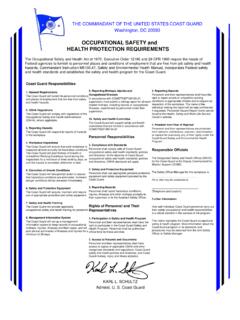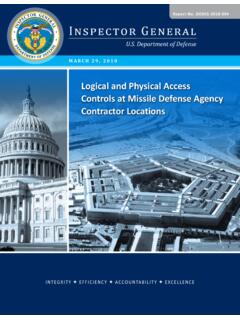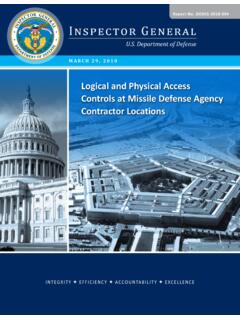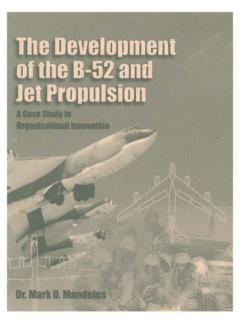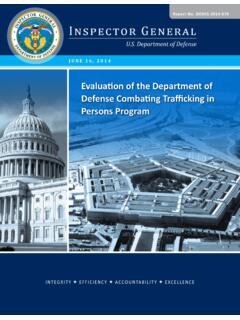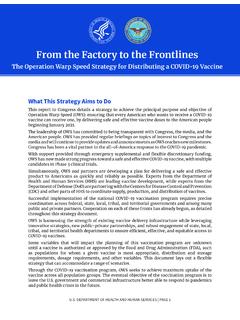Transcription of DOD Digital Modernization Strategy 2019
1 DoD Digital Modernization Strategy Information Resource Management Strategic Plan FY2019 FY2023 Version Prepared by: Office of the DoD Chief Information Officer DoD Digital Modernization Strategy 6/5/2019 Page 2 Change History Version Date Page(s) Changed Comments 5 June 2019 Signed version Cancellation: This document supersedes the following: Department of Defense Information Resources Management Strategic Plan, April 1, 2014 DoD Digital Modernization Strategy 6/5/2019 Page 3 Foreword The global threat landscape is constantly evolving and remaining competitive and modernizing our Digital environment for great power competition is imperative for the Department of Defense. We must act now to secure our future. This Digital Modernization Strategy is the cornerstone for advancing our Digital environment to afford the Joint Force a competitive advantage in the modern battlespace.
2 Our approach is simple. We will increase technological capabilities across the Department and strengthen overall adoption of enterprise systems to expand the competitive space in the Digital arena. We will achieve this through four strategic initiatives: innovation for advantage, optimization, resilient cybersecurity, and cultivation of talent. The Digital Modernization Strategy provides a roadmap to support implementation of the National Defense Strategy lines of effort through the lens of cloud, artificial intelligence, command, control and communications and cybersecurity. This approach will enable increased lethality for the Joint warfighter, empower new partnerships that will drive mission success, and implement new reforms enacted to improve capabilities across the information enterprise. The Strategy also highlights two important elements that will create an enduring and outcome driven Strategy .
3 First, it articulates an enterprise view of the future where more common foundational technology is delivered across the DoD Components. Secondly, the Strategy calls for a Management System that drives outcomes through a metric driven approach, tied to new DoD CIO authorities granted by Congress for both technology budgets and standards. As we modernize our Digital environment across the Department, we must recognize now more than ever the importance of collaboration with our industry and academic partners. I expect the senior leaders of our Department, the Services, and the Joint Warfighting community to take the intent and guidance in this Strategy and drive implementation to achieve results in support of our mission to Defend the Nation. David L. Norquist Performing the Duties of the Deputy Secretary of Defense DoD Digital Modernization Strategy 6/5/2019 Page 4 Executive Summary The DoD Digital Modernization Strategy , which also serves as the Department s Information Resource Management (IRM) Strategic Plan, presents Information Technology (IT)-related Modernization goals and objectives that provide essential support for the three lines of effort in the National Defense Strategy (NDS), and the supporting National Defense Business Operations Plan (NDBOP).
4 It presents the DoD Chief Information Officer s (DoD CIO) vision for achieving the Department s goals and creating a more secure, coordinated, seamless, transparent, and cost-effective IT architecture that transforms data into actionable information and ensures dependable mission execution in the face of a persistent cyber threat. 1 This vision is guided by four priorities and framed within four organizing goals. Figure 1: Digital Modernization DoD CIO Priorities: Cybersecurity Artificial Intelligence (AI) Cloud Command, Control and Communications (C3) Digital Modernization Goals: Innovate for Competitive Advantage Optimize for Efficiencies and Improved Capability Evolve Cybersecurity for an Agile and Resilient Defense Posture Cultivate Talent for a Ready Digital Workforce 1 DoD IT Environment Way Forward to Tomorrow s Strategic Landscape, August 2016 available at DoD Digital Modernization Strategy 6/5/2019 Page 5 This Strategy also fulfills the Office of Management and Budget (OMB)
5 Requirement to provide a description of how information resources management activities help accomplish agency missions, and ensure that information resource management decisions are integrated with organizational planning, budget, procurement, financial management, human resources management, and program It includes narratives that summarize the Department s approach to IT Modernization , focused on the Joint Information Environment (JIE) Framework (in Section 3), and describe how Cybersecurity is being strengthened (Section 4). These efforts support achievement of the DoD CIO s Modernization vision, and the goals and objectives identified in this Strategy . Finally, appendices provide a brief description of promising technologies; tables showing alignment to the NDBOP, the President s Management Agenda, and DoD IT Reform Initiatives, respectively; and a summary of DoD CIO authorities. 2 OMB Circular A-130, Managing Information as a Strategic Resource - available at DoD Digital Modernization Strategy 6/5/2019 Page 6 Contents Foreword.
6 3 Executive Summary .. 4 7 Role of the DoD CIO .. 8 1 DoD Goals and Objectives .. 9 2 Vision, Goals, Objectives, and Strategy Elements .. 11 Vision of the Department s Future Digital Environment .. 11 Goals, Objectives, and Strategy Elements .. 13 Goal 1: Innovate for Competitive Advantage .. 14 Goal 2: Optimize for Efficiencies and Improved Capability .. 24 Goal 3: Evolve Cybersecurity for an Agile and Resilient Defense Posture .. 28 Goal 4: Cultivate Talent for a Ready Digital Workforce .. 33 3 DoD IT Modernization .. 35 Information Technology (IT) Reform .. 38 4 Cybersecurity .. 40 Appendix A: Technologies Offering Promise to DoD .. 44 Appendix B: Alignment to DoD Strategic Guidance .. 53 Appendix C: Alignment with the President s Management Agenda .. 58 Appendix D: Alignment with DoD IT Reform Initiatives .. 62 Appendix E: DoD CIO Authorities .. 63 DoD Digital Modernization Strategy 6/5/2019 Page 7 Context If the Department were a corporation, it would be at the top of the Fortune 100.
7 No organization has a broader mission or scope. DoD is also one of the nation s largest employers, with million active duty military personnel, 742,000 civilian personnel, and 826,000 National Guard and Reserve forces. It manages an inventory of installations and facilities consisting of several hundred thousand individual buildings and structures at more than 5,000 different locations covering over 30 million acres of land. The Department also conducts major activities in almost every business area. These vary from acquisitions to command and control, global logistics, health and medical care, intelligence, space operations, facilities management and more each with critical IT and cybersecurity dependencies. The Department is similarly enormous on the enterprise network scale, operating one of the world s largest and most complex set of networks. As a snapshot, some of DoD s IT statistics include a budget of more than $ billion in fiscal year 2019, roughly ten thousand operational systems, thousands of data centers, tens of thousands of servers, millions of computers and IT devices, and hundreds of thousands of commercial mobile devices.
8 The Department s networks must be mobile enough to support missions around the world, and flexible enough to facilitate collaboration with any partners a mission requires, expected or unexpected. This Strategy highlights DoD CIO-led efforts that are key enablers for accomplishing the Department s missions more effectively and efficiently. The DoD CIO is responsible for all matters relating to the DoD Information Enterprise (IE)3 Most efforts in this Strategy therefore fall within the JIE Framework, which improves networking capabilities for fixed and mobile users, institutes new DoD-wide enterprise IT services, modernizes technology through coordinated refresh efforts, implements a new joint cybersecurity capability, and improves access to data . The JIE Framework also provides a networking design that improves defenses against malicious cyberspace activity and is managed through a tiered structure of network operations and security centers.
9 3 As noted in Department of Defense Directive , The DoD CIO is responsible for all matters relating to the DoD information enterprise, including communications; spectrum management; network policy and standards; information systems; cybersecurity; positioning, navigation, and timing (PNT) policy; and the DoD information enterprise that supports DoD command and control (C2). This directive is available at DoD Digital Modernization Strategy 6/5/2019 Page 8 Role of the DoD CIO The DoD CIO is the Principal Staff Assistant (PSA) and senior advisor to the Secretary of Defense for information technology (IT) (including national security systems), information resources management (IRM) and efficiencies. The DoD CIO is responsible for all matters relating to the DoD Information Enterprise, including communications; spectrum management; network policy and standards; information systems; cybersecurity; positioning, navigation, and timing (PNT) policy; and the DoD Information Enterprise that supports DoD command and control (C2).
10 The DoD CIO is tasked with improving the combat power of the Department as well as its security and efficiency by ensuring that the Department treats information as a strategic asset and that innovative information capabilities are available throughout all areas of DoD supporting warfighting, business, and intelligence missions. The DoD CIO is a vital member of the Office of the Secretary of Defense (OSD) staff that helps the Warfighter by fulfilling its PSA and Clinger-Cohen Act (CCA) roles that guide the Department in the incorporation of more agile, efficient and effective technology and practices. The DoD CIO works closely with other DoD and OSD Components in fulfillment of its responsibilities. As appropriate, the DoD CIO collaborates and coordinates with organizations including (but not limited to) the Chief Management Officer (CMO), the Office of the Under Secretary of Defense for Policy (OUSD(P)), the Office of the Under Secretary of Defense for Acquisition and Sustainment (OUSD(A&S)), the Office of the Under Secretary of Defense for Research and Engineering (OUSD(R&E)), the Office of the Under Secretary of Defense for Intelligence (OUSD(I)), the Military Departments (MILDEPS), Joint Staff, and the Combatant Commands.

